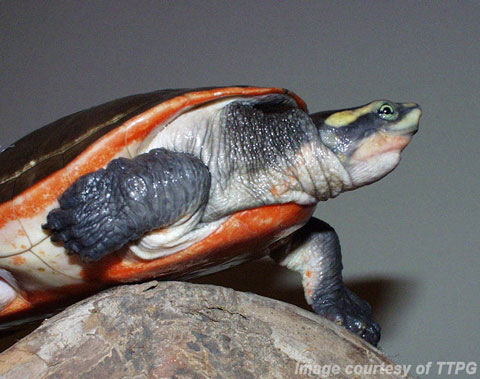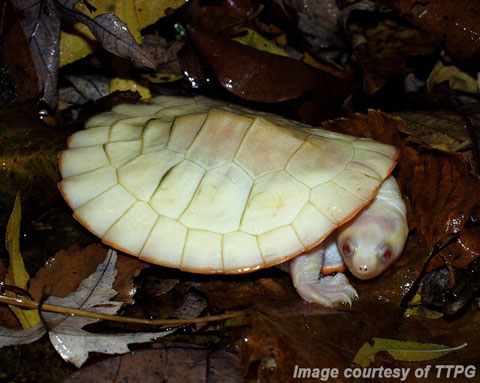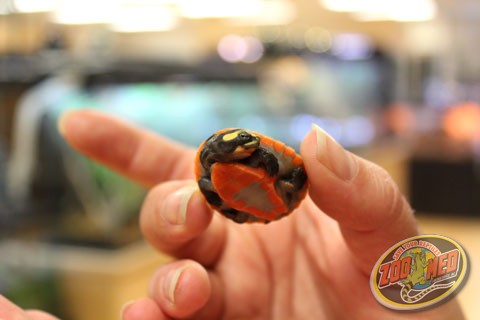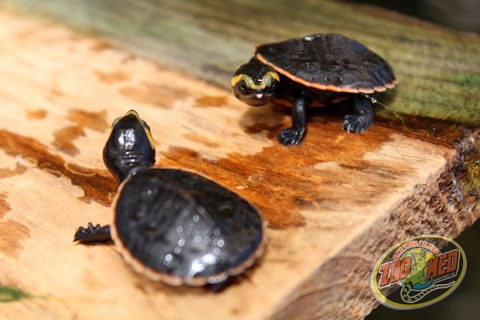by Richard Conniff from Take Part
New information is uncovered about the chytrid fungus, which one expert calls the most significant disease on the planet.

An African clawed frog, the species that first hosted the chytrid fungus in the U.S. (Photo: H. Krisp/Wikimedia Commons)
Ever since The Hot Zone became a nonfiction bestseller 20 years ago, people have been fretting about the likelihood that an emerging pathogen could cause a global pandemic, killing tens of millions of humans. But they seldom pause to consider that it is already happening in the animal world—or that the pandemic that’s now decimating frogs and other amphibians provides a perfect model for how it could also happen to us.

An unresponsive mountain yellow-legged frog, Rana muscosa, infected by the deadly chytrid fungus Batrachochytrium dendrobatidis in the Sierra Nevada. Photo by Dr. Vance T. Vredenburg.
The pathogen this time is the chytrid fungus, which has raced around the world over the past two decades, and now afflicts more than 500 amphibian species in 52 countries. When spores of this fungus penetrate a victim’s skin, a slough of dead cells builds up on the surface, blocking respiration. The electrolytes go out of balance. The brain swells. The frog sits with its legs skewed out oddly to the sides. Death soon follows, often for an entire community of amphibians around a pond or wetland. The chorus of peepers goes silent.
“I can’t think of another disease on the planet more significant than this amphibian disease,” says Peter Daszak, president of EcoHealth Alliance, a New York-based group focused on the role of the wildlife trade in the introduction of dangerous pathogens. “No disease of humans has ever wiped us out.” But he estimates that the chytrid fungus pandemic has already caused the extinction of more than 100 species, including the golden toad in the cloud forests of Costa Rica, the gastric brooding frog in Queensland, Australia, and 20 or 30 species of brilliantly colored Harlequin frogs in Central and South America. “And it’s still causing extinctions.”
A paper being published today in the science journal PLOS ONE adds new evidence to the story of how innocent and even seemingly humane missteps unleashed this killer on the amphibian world. Maybe it’s best to start with our own families: For anyone born from the 1920s up until the late 1970s, the way our mothers generally got the happy news of our impending arrival was by way of the African clawed frog, an East African species in the genus Xenopus.

Great Barred Frog from Queensland with chytrid infection
“For people who think of beautiful tree frogs and lovely poison dart frogs, these aren’t those frogs,” says Sherril Green, who is the lead author of the new study. “They are not warm fuzzy poster frogs. They have black or dark green skin. They’re very slimy. They’re carnivorous, cannibalistic, and scavengers.” Along with an almost unlimited menu of other foods, they will sometimes even leap out of the water to take an injured bird. But mostly, says Green, who is a veterinarian and chair of comparative medicine at Stanford University School of Medicine, they survive by eating a percentage of their own young.
Sometime in the 1920s, researchers who had imported these frogs for their studies discovered that injecting them with the urine of a pregnant woman caused female clawed frogs to begin producing eggs. That quickly became the standard human pregnancy test. Then in the 1970s, a simple blood test replaced it, and hospitals and medical laboratories around the world found themselves with a lot of surplus frogs on their hands. Some of them apparently decided that, rather than euthanize the animals, it was more humane to release them into the wild. (Accidental releases from pet shops and zoos may also have been a factor.) No one suspected then that the African clawed frog was an asymptomatic carrier of the chytrid fungus.

The gastric-brooding frogs or platypus frogs (Rheobatrachus) were a genus of ground-dwelling frogs native to Queensland in eastern Australia. The genus consisted of only two species, both of which became extinct in the mid-1980s.
For the new study, Green and her co-authors caught these frogs in the wild around California, including one from the Lily Pond in San Francisco’s Golden Gate Park and two from San Diego. They found the chytrid fungus on some of these living specimens, and also on preserved specimens at the California Academy of Sciences. One specimen, collected in 1934 in Kenya, is now the earliest case of chytrid fungus on record, supporting the theory that the pandemic originated in Africa. Green believes that after the release of the frogs in the 1970s, the chytrid fungus took several decades building up among amphibian communities in California, then broke out 10 or 15 years ago. It has since caused massive declines in species like the yellow-legged frogs in the Sierra Nevada Mountains.
This has been a terrible devastation to the wildlife community, but why should we worry that it could affect us directly? Peter Daszak of Ecohealth Alliance notes that the United States is now the world’s biggest market for the legal wildlife trade, much of it to supply the pet market with exotic rodents, amphibians, and reptiles. Just as no one knew that the African clawed frog carried the chytrid fungus, no one knows what pathogens these pets may carry.
In April 2003, for instance, a shipment of 800 rodents of nine species arrived in the United States from West Africa. One pet dealer kept Gambian rats from that shipment in a cage adjacent to some prairie dogs, and over the next two months, 93 people who had contact with pet prairie dogs came down with monkeypox, a viral disease akin to smallpox. Everyone survived the outbreak and the U.S. government subsequently banned importation of African rodents. But rodents from South America and Asia remain legal. The U.S. government only regulates or bans trade in a species, says another EcoHealth staffer, “after a disease has occurred.”
The answer, says Daszak, isn’t to ban trade. “When you ban trade it just creates big conflicts with people who have jobs in that industry or make money in that industry.” Instead, EcoHealth Alliance has established a service called PetWatch, modeled on the Monterey Bay Aquarium’s Seafood Watch, to alert consumers to the best and worst choices in exotic pets. “What we’re trying to say is that the alternative for the industry is to captive-breed these animals in the United States and Europe. It’s a little bit more expensive, but you can make more money at it because you can sell the animals at a higher premium. People will pay more for a healthy animal than for a wild-caught animal that’s in rough shape and that may be carrying diseases with it. If we can shift the industry from wild-caught to captive bred, we not only reduce the health risks, but also the impact on conservation.” The pet industry now serves on the advisory board for PetWatch, and the ambition is to develop a rating system to identify wholesalers and pet shops that move to healthier practices.
So far, biomedical and other research laboratories have not started making these kinds of changes. “The use of animals for research is very well-regulated for animal welfare issues,” says Daszak, “but not for conservation issues.” So, many facilities still use some wild-caught animals. As long as that practice persists, the next chytrid fungus pandemic—or the next human Hot Zone—could be heating up in our own living rooms.














![Crocodylus porosus [Juvenile] - © Dave Wilson](http://aquaticlife.angfaqld.org.au/C_porosus.jpg)
